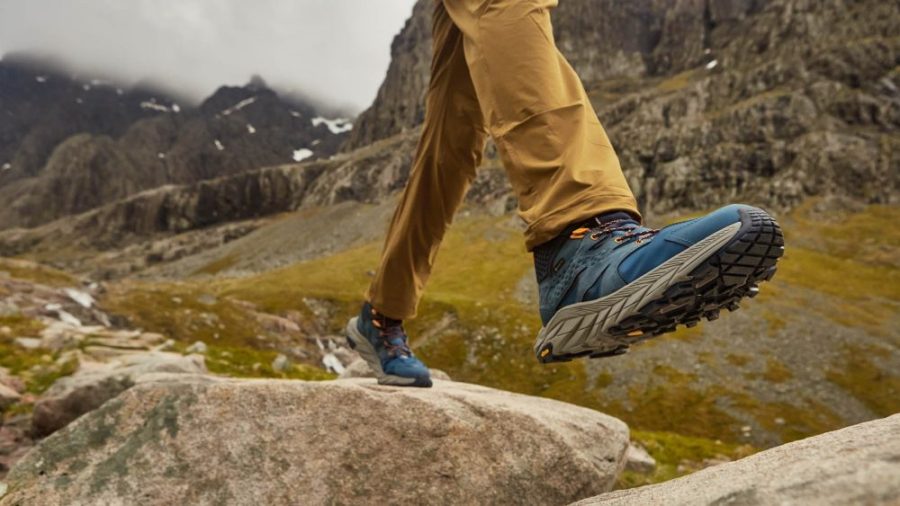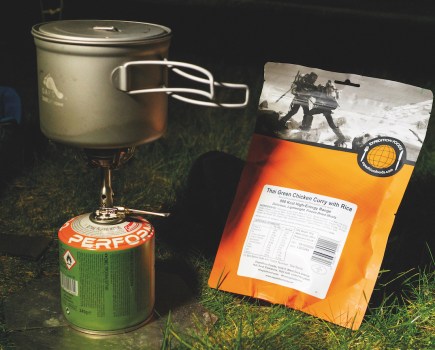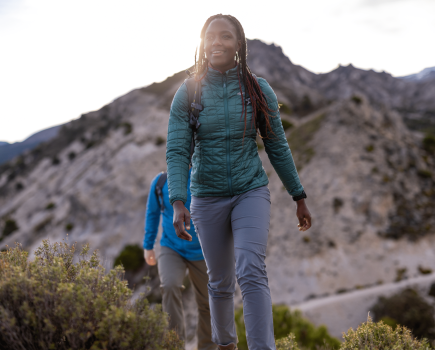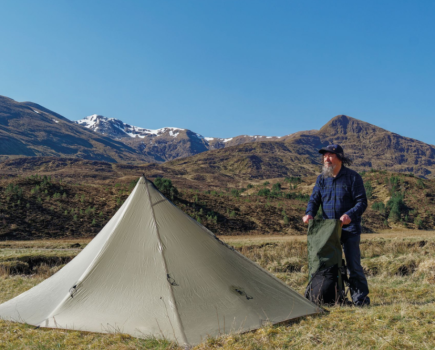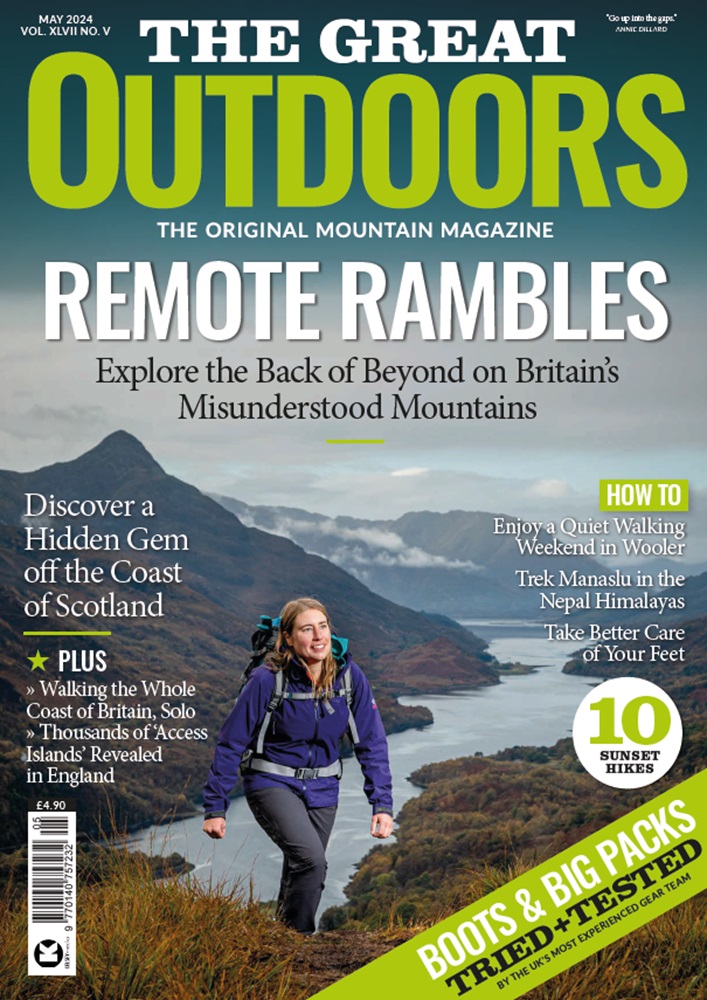Hiking boots come in a range of different styles and some models can be made for specific types of activities. You can, for instance, find heavy-duty walking boots designed for alpine treks and then you can also find lightweight ones that are designed just for short dog walks.
Generally, like two-person tents, hiking boots are designated by their season. Four-season ones tend to be stiff-soled, warm and suited to conditions where snow and ice are expected. On the flip side, one-season boots will be light, airy and designed for hot and humid weather. If you’re looking for a pair of hiking boots that will serve you well throughout a range of different types of walking, hiking or trekking, then your best bet is to look for a pair regarded as ‘three-season’ – that means boots designed for use from the milder part of spring through to the milder part of autumn.
The best pair of hiking boots for any general outdoor adventures will need to tick a number of boxes and strike certain balances. They’ll need to have a sturdy sole that can cope with rocky terrain but there will also need to be a bit of flex to make the wearer comfortable when covering long distances. They’ll need a sole that can grip reliably to a range of surfaces, from wet rock to muddy slopes, plus you’ll want to look for padding and cushioning that will keep you comfortable but without causing overheating if you do need to wear the boots in warmer temperatures. You’ll find more about what to look for when choosing a pair of hiking boots at the bottom of this article, or you might want to check out this in-depth hiking boot buyer’s guide we compiled.
The best hiking boots reviewed 2024: 11 options for walking and backpacking
Our experienced gear testers have assessed a broad range of options for this group test, with aspects such as performance, price, reliability and longevity all taken into consideration. The following shows the hiking boots for men and women that have come out on top.
How we tested them
Just as we do with everything from our waterproof jackets, trail shoe and sleeping bag reviews, these hiking boots were all tested extensively by outdoor industry professionals within our gear review team. In this instance, our testers were Peter Macfarlane, Kirsty Pallas, Fiona Russell, Lara Dunn, David Lintern and John Manning. They were all responsible for the testing and reviewing throughout the entire process and they carried out their assessments in mountainous locations throughout the UK, including in the Cairngorms, Inner Hebrides and the mountains of Wales. The testing season ranged from spring through to autumn and involved short and long hikes over mix terrain. All shoes were assessed for their breathability, performance in wet weather, grip, comfort and durability, all weighed up against the price.
Inov-8 Roclite Pro G400 GTX V2
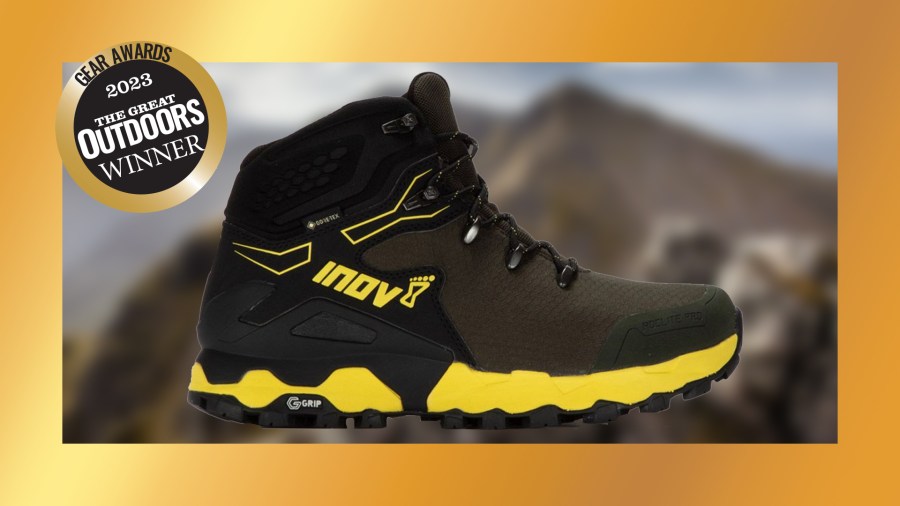
TGO Gear Awards Winner – 2023
Lightweight, very comfortable, grippy on a wide range of terrain, these are my go-to walking boots for most of the year in Scotland- Comfort
- Flexibility
- Grip
- Price
- Limited larger sizes
- Weight quibble
| Quick specs | |
|---|---|
| Price: $245 / £200 Weight: 1.87 lb. / 850g Pros: Comfort, flexibility, grip Cons: Price, limited larger sizes, weight quibble Materials: Schoeller ceramic-coated fabric upper, Gore-Tex membrane, graphene-enhanced rubber soles Features: sole with ‘iconic’-shaped studs and water dispersion grooves, ‘meta plate pro’, external heel cage Men’s version: yes Sizes: U.S. 5.5 to 11 / UK 3.5 to 8.5 (including half sizes) |
Inov-8’s main specialism lies in trail running and there’s a big focus on lightweight performance throughout the brand that extends into their hiking collection. Case in point: the Roclite Pro G400 GTX V2 which picked up the award for best hiking boots in The Great Outdoors Awards 2023. It’s a light, versatile boot that fits like a slipper, with a narrow to mid-width fit and a smooth but precise lacing system. The upper, which is made from synthetic mesh, is lined by a Gore-Tex waterproof membrane and there’s light protection at the toe and at the heel where there’s a stabilising external rubber structure.
Then there’s the impressive outsole. This contains graphene, a substance that’s commonly regarded as one of the toughest materials in the world. Inov-8 use this across most of their collection these days in order to increase the lifespan of their products. You’ll find 6mm trail shoe-like lugs across the outsole too, making the Roclite Pro G400 ideal for muddy conditions. The grip is generally good except on wet rocks and tree roots, and the uppers are durable and resist abrasion. Sole rigidity is lacking, so look elsewhere if you prefer a stiffer sole.
“Lightweight, very comfortable, grippy on a wide range of terrain, these are my go-to walking boots for most of the year in Scotland,” said Fiona Russell, part of our awards jury. “They are as comfy as a favourite pair of running shoes but with extra ankle support.
Read our full inov-8 Roclite Pro G 400 Gore-Tex women’s boot review
Aku Rock DFS Mid GTX

TGO Awards 2023 Highly Commended
Highly commended in The Great Outdoors Awards for 2023, the Aku Rock DFS Mid GTX is a technical approach and light climbing shoe- Comfy
- Breathable
- Versatile
- Lightweight
- Tongue could do with more padding
| Quick specs | |
|---|---|
| Price: $180 / £180 Weight: 400g Materials: fully waterproof and breathable suede and synthetic upper / Gore-Tex lining Features: Vibram Approcciosa Megagrip outsole, double density EVA and PU midsole, Ortholite hybrid footbed Sizes: 4-12. |
Highly commended in The Great Outdoors Awards for 2023, the Aku Rock DFS Mid GTX is a technical approach and light climbing shoe – something that’s ideal for via ferrata and excursions on mountain paths.
The DFS in its name stands for Dual FitSystem. This involves a traditional lace for maximum comfort whilst walking plus a fast lace toggle system to increase precision when climbing. Will Renwick, who was part of the awards jury, described this lacing as “unique” but also “effective”, saying that it “allows you to really dial in the fit to exactly how you want it.
The Rock DFS also features a hard-wearing, breathable upper with a Gore-Tex membrane and big rubber rand around its base. The midsole is quite stiff but it’s still comfortable for covering long distances and there’s a nice rock to the shoe that helps to create a smooth, almost effortless walking stride.
Available at: aku.it
Scarpa Mojito Hike GTX
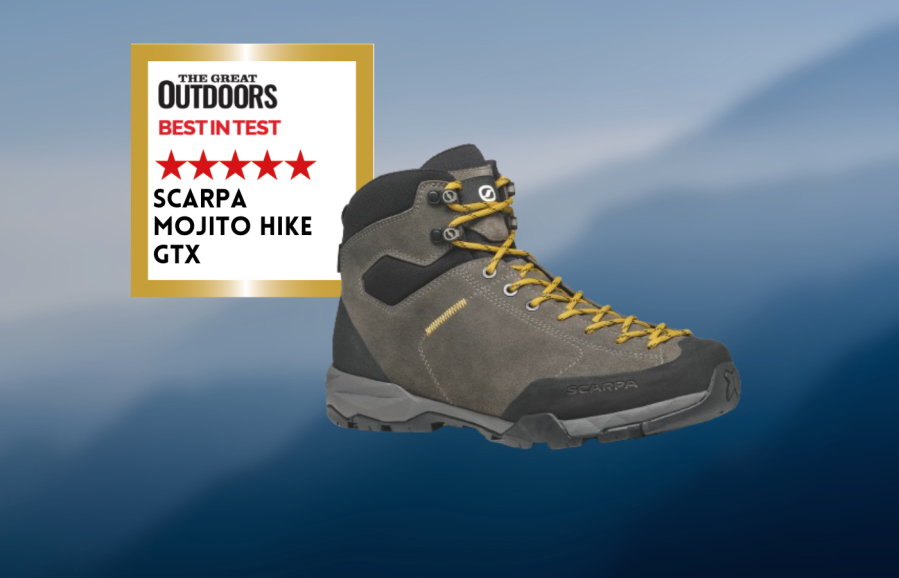
John Manning’s Best In Test
At £205 it’s the pricey – but that’s the price of quality and comfort.- Comfort
- Weight
- Stability
- Full Boot Lacing
- Traction
- Low Instep
- Price
| Quick specs | |
|---|---|
| Price: £205 Weight: 970g (stated, men’s size 8/EU42)/1,195g (on JM’s scales, men’s size 10.5/EU45) Eco/ethical claims: Bluesign-approved Gore-Tex lining materials; resoleable by Scarpa; Scarpa publishes a Green manifesto. Materials: 1.8mm Ware resistant suede upper; Gore-Tex lining Features: Vibram XS Trek rubber outsole; Gore-Tex BlueSign-approved membrane; round core laces Sizes: men’s 7–13/EU41–48; women’s 3.5–8/EU36–42 Women/men’s version: Yes URL: www.scarpa.co.uk |
The Mojito Hike GTX is a hiking boot designed to resemble a climbing shoe, offering a comfortable and supportive walking experience. The boot features a climbing shoe-like lacing system, allowing for a precise, supportive fit throughout the boot. The suede upper’s stiffness ensures minimal shift, allowing for a comfortable hike without constant pauses.
The boot is rated as medium fit, providing room for comfort without shifting or tightness. The Vibram XS Trek rubber outsole provides decent traction and a natural walking action, while the half-centimeter instep aids braking on slopes. The suede upper initially runs off when crossing flooded ground, but later darkens as moisture absorbs moisture.
A rubber bumper at the front protects the toes from rock impacts, but the toe area is roomy enough to avoid toe battering during descents. At £195, the Mojito Hike GTX falls within the acceptable weight range for comfort, making it a great choice for those seeking quality and comfort.
Read John’s full Scarpa Mojito Hike GTX Review
Salewa W’s Alp Trainer 2 Mid GTX
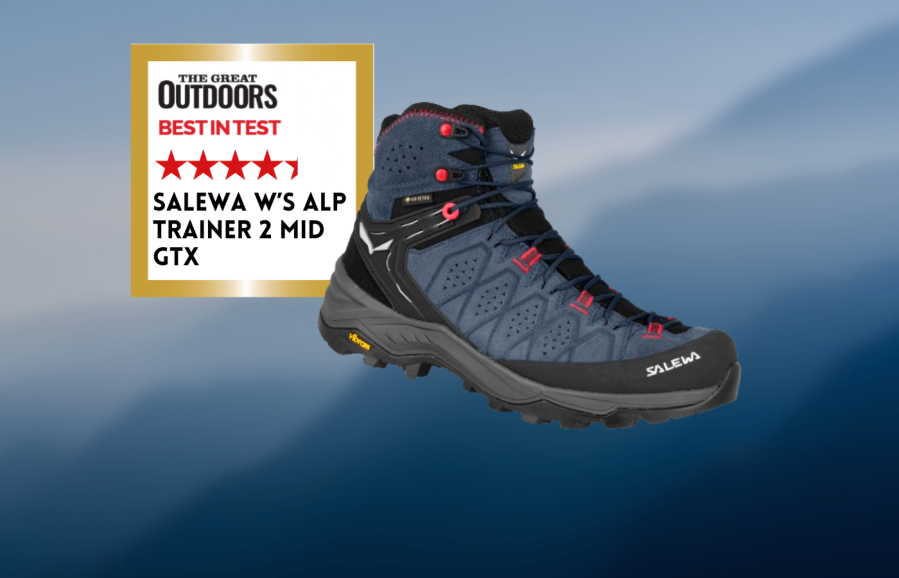
Lara Dunn’s Best in Test
comfortable and supportive fit and the good looks too, these mark excellent value for money, coming in as they do at a cheaper price that most similar boots.- Less expensive than equivalent boots
- Light
- Supportive
- Attractive
- None
| Quick specs | |
|---|---|
| Price: $200 | £190 Weight: 1018g (for size 41) Pros: Less expensive than some equivalent boots, light, supportive, attractive Cons: None really Materials: Suede leather uppers, Vibram Alpine Hiking outsole, Gore-Tex lined Features: Multifit Footbed + interchangeable footbed for fine tuning volume, protective toe rand, locking laces Sizes: UK3-UK9 (including half sizes)/EU36-43 Women’s/Men’s Version: Women’s (men’s direct equivalent available) www.salewa.com |
The Alp Trainer 2 Mid GTX hiking boots from Salewa are a versatile choice for day walks with a light pack or longer treks with a heavy load. They have a continental look with an asymmetric toe rand, reminiscent of climbing shoes. Despite being sent the wrong size due to a technical issue, the boot’s comfort and customisable footbed make it suitable for most terrains and load carrying. The Vibram outsoles are grippy and easy to shed mud, making them ideal for claggy conditions.
The boot is high enough to support the ankle even with a heavier load and keeps debris and mud out. The Gore-Tex content ensures versatility for damp UK hiking conditions. The boots are excellent value for money, with attention to detail, quality build, comfortable fit, and attractive looks.
Read Lara’s full Salewa W’s Alp Trainer 2 Mid GTX Review
Altberg Ladies Fremington
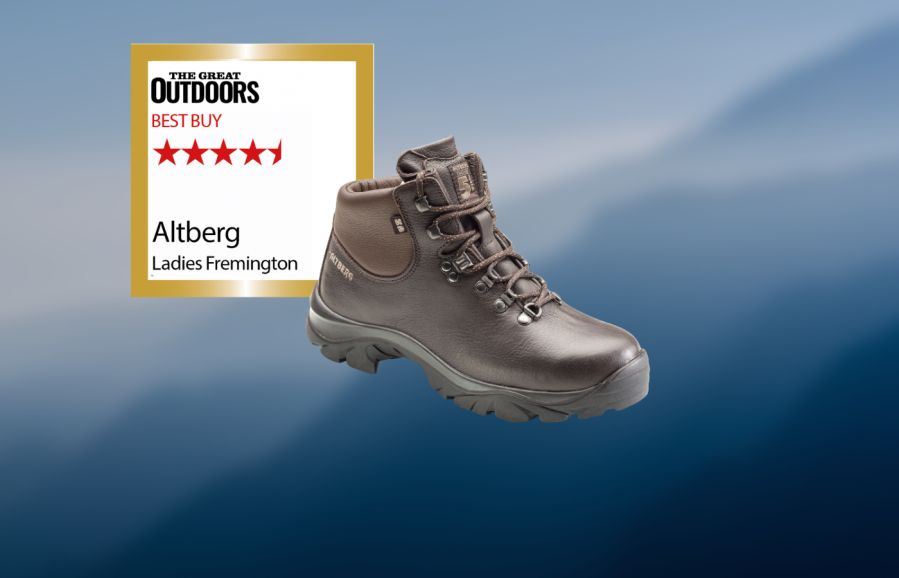
Lucy wallace’s Best in Test
Aesthetically, these will not be everyone’s taste, but the retro style conceals a boot that out-competes modern styles on weight, comfort and fit, making this a classic boot for summer use- Width fittings
- Comfort
- Relatively light
- don’t easily attach to laces
| Quick specs | |
|---|---|
| Price: £210 | No U.S Weight: 2.7 lb. / 1226g Pros: Width fittings, comfort, relatively light Cons: Gaiters don’t easily attach to laces Rating: 4.5/5 Materials: leather upper, Sympatex waterproof membrane, Vibram Masai sole Features: padded ankle cuff, one-piece leather upper, full rubber rand Sizes: UK3-8.5/ EU 35-41, width fittings XN-XW Men’s version: yes |
Altberg, a British leather footwear manufacturer, produces the Fremington, a lighter model available in five width fittings. The uppers are made from full-grain leather with a Sympatex membrane, making them waterproof. The Vibram outsole is rugged and suitable for various terrains. A protective rubber rand skirts the rim, but does not cover the toe cap. The midsole is supportive and lightweight, with good shock absorbency. Altberg emphasizes the importance of maintaining the leather and offers care products for sale. The retro style of the Fremington outperforms modern styles in weight, comfort, and fit, making it a classic boot for summer use in the British countryside.
Read Lucy Wallaces full Altberg Ladies Fremington review
Hanwag Blueridge ES
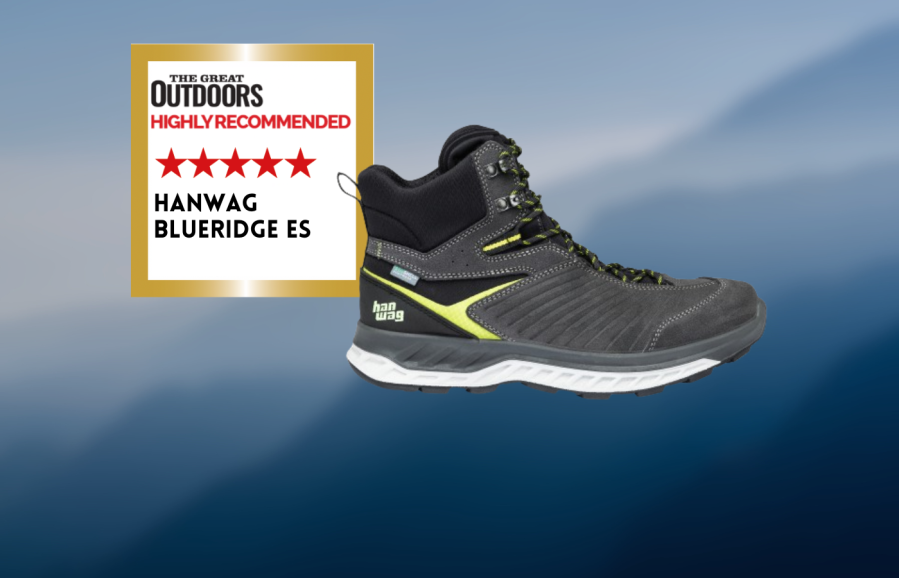
John Manning Highly Recommends
I’ve never experienced a more comfortable boot.- Comfortable Tongue
- Comfy Fabric
- Price
- Double Hook Lacing
- Low Instep
- Flexible
| Quick specs | |
|---|---|
| Price: $270 | £185 Weight: 1120g (stated, men’s size 8/EU42); 1342g (on JM’s scales, men’s size 10.5/EU45) Eco/ethical claims: manufactured in Hanwag’s European factories from 100% European-sourced fully traceable components; upper made from Perwanger leather (from certified Alpine region suppliers, produced using minimal water and energy) and 100% recycled polyamide; PFC-free Eco-Shell membrane; Hanwag Hike Pro 15% recycled rubber outsole; Sustainable Apparel Coalition member Materials: hydrophilic PFC-free EcoShell membrane; Perwanger suede and recycled polyamide upper fabric upper; Hanwag Hike Pro outer sole; EcoShell lining; PU foam Breathfit tongue Features: Terragrip outsole with 4mm-deep tread and extra-large lugs; made in Europe using fully traceable European components Sizes: men’s 6–13 (EU39.5–48.5) including half sizes; women’s 3.5-9 (EU36–43) including half sizes Women/men’s version: both URL: www.hanwag.com/uk/en-gb |
The Hanwag Blueridge ES hiking boot is a comfortable and luxurious option, thanks to its design and the combination of tongue, collar, and upper Perwanger suede. The tongue is made of soft PU foam with Breathfit padding, resembling neoprene used in diving suits. The collar is a lightly padded foam-padded fabric, while the upper is a soft, luxuriant Perwanger suede that gently embraces the foot.
The sole is not as rigid as some, but the flex point is just right for the user. The sole offers good traction on various surfaces and shows signs of wear after just a few weeks, but the boot can still provide a few hundred miles of use. The Hanwag Blueridge ES is the heaviest tested boot, but its comfortable fit and sensual suede upper fabric make it a great choice for hiking.
Read John’s full Hanwag Blueridge ES Review
Meindl Bhutan Lady MFS
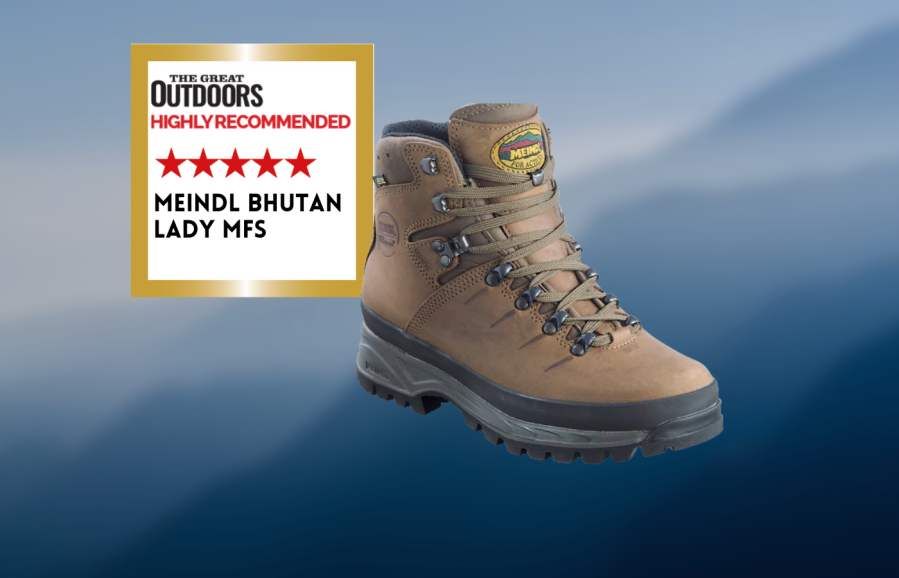
Lara Dunn’s Highly recommended
These are a bit like an original Landrover Defender pitted against newer, racier four-wheel drive vehicles. This boot has been one of Meindl’s bestsellers for over 10 years and it’s easy to see why.- Repairable
- Supportive
- Well-made
- Pricey
| Quick specs | |
|---|---|
| Price: $280 | £279.99 Weight: 1368g (for size UK6) Materials: Nubuck leather, Gore-Tex lining, Meindl Multigrip Vibram rubber outsole Features: Memory Foam System in ankle area, Digafix lacing system for superior hold and fit adjustment Sizes: UK3.5-UK9 (including half sizes)/EU36-43 Women’s/Men’s Version: Women’s (men’s direct equivalent available) www.meindl.co.uk |
The Bhutan Lady MFS are lightweight hiking boots that are both durable and lightweight. They have been a bestseller for over 10 years and feature a tough nubuck upper, Gore-Tex lining for waterproofing, and a Memory Foam System at the ankle for extra comfort. The Vibram double-density sole unit is self-cleaning and mud-shedding. The boots come in half sizes, making them easy to fit for average-shaped feet. The ankle support area is superbly comfortable, and there is enough flexibility to encourage a natural gait. The boot is designed to be stiff enough to tackle all but high mountain and winter conditions. Meindl’s approach to boots is repairable for long-term wear, allowing them to be sent to Meindl UK and then to Germany for rejuvenation. This sustainability helps keep the boots going indefinitely, making them a popular choice for those looking for a durable and comfortable hiking boot.
Read Lara Dunn’s full Meindl Bhutan Lady MFS Review
Aku Trekker Lite III GTX

John Manning Recommends
The deepest, sturdiest, most formidable of the hiking boots tested in this sample group, and the one that looks most at home in the mountains.- triple hook lacing system
- deep instep
- comfort
- security
- wider fit available (not online)
- Price
| Quick specs | |
|---|---|
| Price: $300 | £200 Weight: 1,140g (stated, men’s UK size 8/EU42)/1,283g (on JM’s scales, men’s size UK 10.5/EU45) Eco/ethical claims: Behind the Label traceability of materials; materials sourced within European (German, Italian and Romanian) to reduce transportation; ReAct Responsibly sustainability stance; £8 + VAT from each sale goes to The Ramblers’ access campaigns Materials: air8000 suede with welded PU film upper; Gore-Tex Performance Comfort membrane; Vibram Curcuma outsole; double density EVA midsole; 6–4 mm nylon with microporous EVA lasting board Features: soft, custom fit footbed; wide versions available; materials traceable online Sizes: men’s 6.5–15 (EU39.5–48/49); women’s 3–9 (EU35/36–41/42) Men’s/womens: both AKU.co.uk |
The Trekker Lite III GTX is a lightweight, supportive boot that is perfect for mountain hiking. It weighs 1,283g per pair (size 10.5) and is supportive around the ankle, with a rigid base and heel cup. The Vibram Curcuma outsole provides excellent grip on damp limestone and wet vegetation. However, the firm upper and minimal flex in the sole make foot placement on uneven ground more cautious.
The lacing system is excellent, with laces extending down to the toe box for a secure fit. Round core laces thread through metalware up to three pairs of hooks, ensuring no loss of tension when tying the boot off at the ankle. The boots are made in Aku’s Romanian factory using traceable materials from Europe and are made with traceable materials. Sales also support The Ramblers’ campaigns to protect access to green spaces and rights of way.
In summary, the Trekker Lite III GTX is a comfortable and durable boot that is well-suited for mountain hiking. Its lightweight design, support for traceable materials, and support for environmental causes make it a popular choice for those seeking a durable and comfortable hiking boot.
Read John’s full Aku Trekker Lite III GTX Review
Berghaus Deception Trail GTX
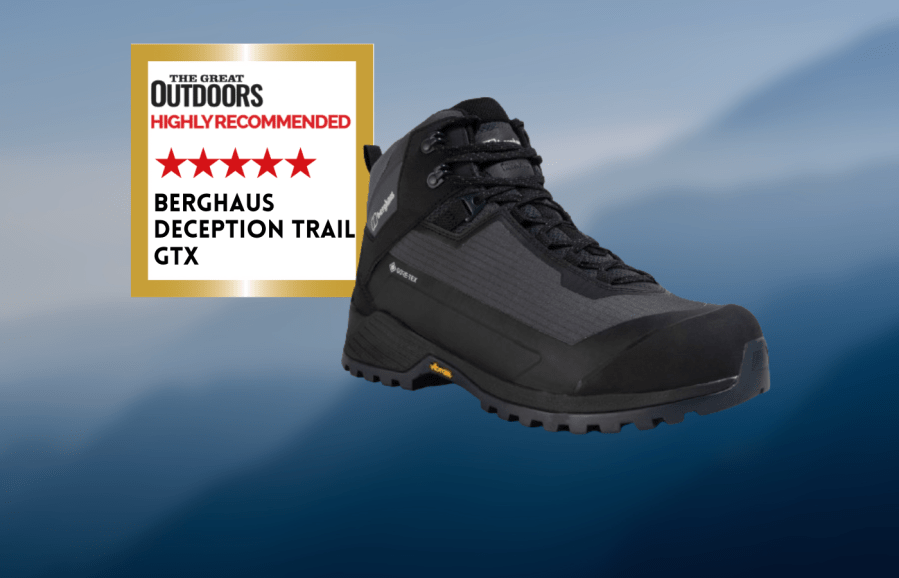
John Manning Highly Recommends
The Berghaus Deception Trail GTX hiking boot is a mid-cut, yet ever-so-slightly deeper in the ankle than your average mid; I found that matter of just a half-centimetre or so made a welcome difference- Price
- Comfort
- Weight
- double-hook lacing system
- Traction
- Deep Instep
- None
| Quick specs | |
|---|---|
| Price: £170 Weight: 1023g (stated, men’s size 9/EU43); 1,119g (on JM’s scales, men’s size 10.5/EU45) Eco/ethical claims: 100% synthetic boot; Repairhaus service; sustainability report; member of the Sustainable Apparel Coalition, B Corp, and the global Ethical Trading Initiative; annual open and transparent Positive Business Report on actions & initiatives Materials: polyester upper; Gore-Tex membrane; Opti-Stud Vibram rubber outsole Features: mid-cut; Ortholite footbed; no animal-based materials Sizes: UK 7–12 (including half sizes)/EU 40.5–47 Women/men’s version: both URL: www.berghaus.com |
The Berghaus Deception Trail GTX hiking boot is a mid-cut boot with a slightly deeper ankle than average mid-cuts, providing a sense of security and confidence on the fell. The sole has a slight lateral flex, making it spike-friendly-stiff and allowing for easy foot placement without dictating foot placement. The sole’s semi-rigidity has not softened off after initial wear.
The boot features a protective rubber bumper at the front, which protects toes from trailside rock, and a light rubber rand around the outside edge of each boot. Ankle support is excellent, with a synthetic cup supporting the heel and a substantial collar holding the ankle without being over-restrictive. The lacing system, consisting of four pairs of loops and two pairs of hooks, helps relieve rubbing on the left foot. The laces are 5mm fabric flatties, which fasten more securely and are longer-lived than round cord laces.
The sole provides reliable traction on various terrains, with a reasonable instep aiding braking on crumbly descents. The boot is substantial, supportive, roomy, and rigid, making it the lightest boot among the test group and one of the most comfortable.
Read John’s full Berghaus Deception Trail GTX Review
Zamberlan Salathe Trek GTX RR
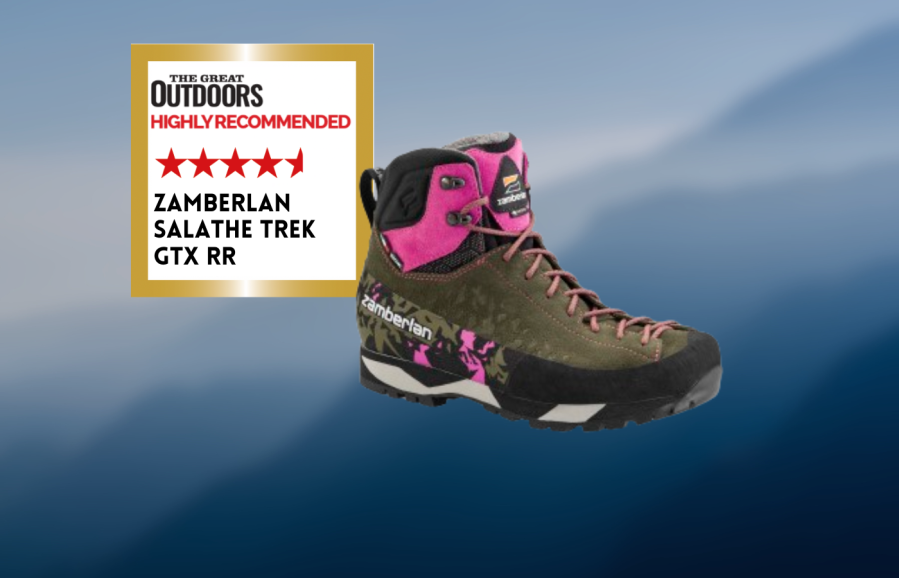
Lara Dunn’s Highly Recommended
These are an exceptionally comfortable, supportive, capable and well-designed pair of boots and I would have happily awarded them 5 stars if it hadn’t been for that price. They are a solid investment.- Light
- Versatile
- Supportive
- RECCO Reflector
- Style won’t appeal to all
- Expensive
| Quick specs | |
|---|---|
| Price: $330 | £260 Weight: 908g (for size 39) Pros: Light, versatile, supportive, RECCO reflector Cons: Style won’t appeal to everyone, expensive Materials: Hydrobloc Suede, Gore-Tex lining, molded EVA midsole, Vibram Megagrip outsole Features: RECCO reflector, Gore-Tex lining and waterproof leather upper, laces right down to toe-box Sizes: UK4-UK9 / EU37-43 (including half sizes) Women’s/Men’s Version: Women’s (men’s direct equivalent available) www.zamberlan.co.uk |
The Zamberlan Salathe Trek GTX RR hiking boots are a lightweight, modern alpine boot with asymmetric pointed toe and protective toe rand. They come in various colors and have funky graphics. Although built on a unisex platform, the boots are comfortable and suitable for various activities, including day walks, scrambles, and alpine hikes. The outsoles are well-suited for various terrains and conditions, and the protective asymmetric toe makes leaping from rock to rock appealing. The boots also feature a waterproof suede upper, Gore-Tex lining, and Vibram sole. The RECCO reflector is included to aid rescue services in locating the wearer. Despite their price, these boots are an excellent choice for those looking for a comfortable, supportive, capable, and well-designed pair of boots.
Read Lara’s full Zamberlan Salathe Trek GTX RR Women’s Review
La Sportiva TX5 GTX

Lara Dunn Highly Recommends
These are a capable and well-made hiking boot, perfect for hiking and trekking on varied terrain, making the £200 a sound investment in a very versatile and wearable piece of kit.- Light, supportive and grippy.
- Versatile for various conditions and surfaces.
- Worth checking the fit
| Quick specs | |
|---|---|
| Price: $250 | £200 Weight 930g (for size UK6) Materials: Nubuck leather, Gore-Tex Extended Comfort lining, EVA shock-absorbing insole, Vibram MegaGrip outsole Features: Ortholite Approach 4mm footbed, rubber protective rand on upper, 3D Flex system for protection and precision Sizes: UK3.5-UK8 (EU36-42 including half sizes) Women’s/Men’s Version: Women’s (men’s direct equivalent available) www.lasportiva.com |
La Sportiva’s TX5 GTX hiking boots are lightweight yet rugged, designed for long-day wear in challenging conditions or with heavy loads. They offer a generous fit, suitable for narrow heels but not too wide for the average British foot. The boots are comfortable and capable over various terrains, with a shaped toe area and deep protective rand. They are warm but not overwarm, suitable for year-round use, and have a Gore-Tex that keeps out wet stuff. The Vibram MegaGrip outsole performs well on various surfaces and weather conditions. The Ortholite Approach 4mm insole is cushioned for long days with a heavy pack, and the boot’s stiffness and support offer support even with a slightly lower ankle height. The lightweight boot is particularly good for those who prefer a faster pace with a smaller pack. The La Sportiva TX5 GTX is a versatile and wearable piece of kit, making the £200 investment a sound investment.
Read Lara Dunn’s full La Sportiva TX5 GTX Review
Vivobarefoot Tracker Winter SG
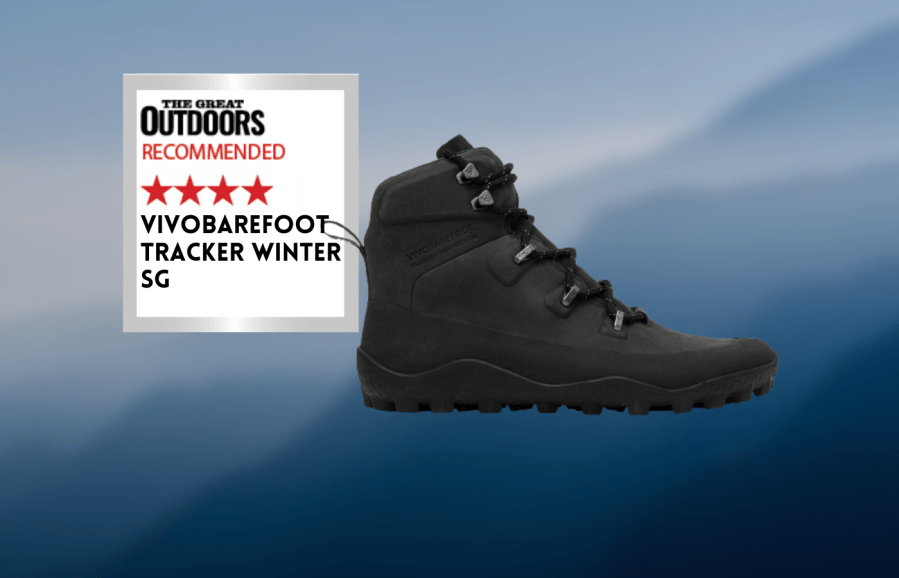
Lara Dunn Recommends
For colder season use, these are a great addition to a barefoot hiker’s kit cupboard- Sensitivity to trail
- Lightweight
- flexibility
- Not the warmest
| Quick specs | |
|---|---|
| Price: $270 | £210 Weight: 870g (for size UK6) Pros: Sensitivity to trail, light weight, flexibility Cons: Not the warmest Materials: Wild hide leather, 50% wool/50% polyester lining, polymer/silica mix outsole, unspecified waterproof membrane Features: Low-profile, flexible barefoot-style fit, waterproof treatment to leather uppers and waterproof membrane in boot, removable/replaceable thermal insole Sizes: UK2.5-UK9 (EU35-43) – half sizes only at UK2.5 and UK8.5 Women’s/Men’s Version – women’s (men’s direct equivalent available) www.vivobarefoot.com |
The Vivobarefoot Tracker Winter SG is a rugged winterized boot designed to be both weatherproof and warmer. It offers feedback and sensitivity in hiking boots and shoes, making them suitable for cold weather wear. The SG “soft ground” outsole and wider sole profile provide good traction in mud, but not technical winter footwear with crampon capacity. The thermal insole and thicker outsole provide more insulation than other Trackers, but require thick socks and a fast pace to prevent warmth from seeping out. The waterproofing function also works well. While not as stable for carrying heavy loads as traditional boots, they are well-suited for a day out with good leg strength and confidence. The ankles are comfortably supported but not constrained, and the ability to adjust to the terrain is excellent. For colder season use, these boots are a great addition to a barefoot hiker’s kit cupboard.
Read Lara Dunn’s full review on the Vivobarefoot Tracker Winter SG
Oboz Sawtooth X Mid B-Dry
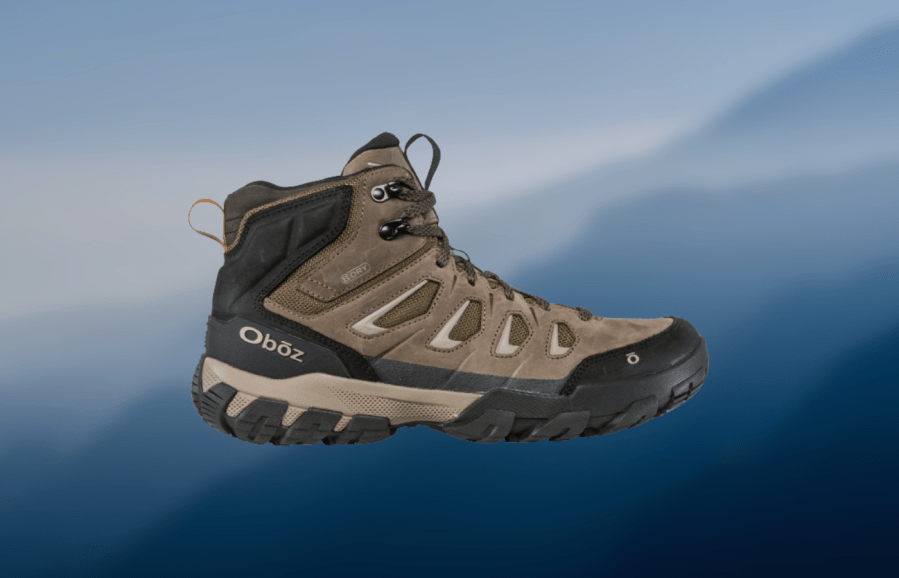
John Manning’s verdict
The Oboz Sawtooth X Mid B-Dry is not overly heavy: of the half-dozen test in recent weeks, its weight was a only smidge above average and wasn’t going to tire my feet.- Style
- Supportive
- Double-hooking lacing system
- Good Traction
- Price
- Snug
- Runs warm
- Low Instep
| Quick specs | |
|---|---|
| Price: $165 | £175 Weight: 1,100g (stated, men’s size 9, EU43); 1,256g (on JM’s scales, men’s size 10.5/EU45) Eco/ethical claims: tree planted for every pair sold; recycled materials; Sustainable Apparel Coalition member Materials: oiled nubuck and Cordura fabric mesh upper; TPU heel counter; B-Dry waterproof membrane; RPET Repreve laces; RPET Repreve webbing; Trail Tread rubber sole Features: standard width and volume; flat laces Sizes (UK/EU): men: 6–13 (EU 39–48) inc half sizes; women: 3.5–8.5 (EU 36–42.5) Women/men’s version: both URL: obozfootwear.com/en-gb |
The Oboz Sawtooth X Mid B-Dry is a mid-cut hiking boot with an oiled nubuck leather and Cordura fabric upper. It features a flat-laced lacing system and an exo-skeletal-styled upper, with laces and webbing made from Repreve polyester. The boot has a dual density ACT+ rubberised EVA midsole for excellent cushioning. The trail Tread rubber compound outsole provides impressive traction over various terrains, and the dual density ACT+ rubberised EVA midsole provides excellent cushioning. The boot needs a few days of breaking-in due to its snug collar and slightly less supportive over time. The weight is not overly heavy, but the boot ran hot. The boot’s snug fit and insulation properties may contribute to the warmth experienced. The Sawtooth Mid is available without a membrane, but extended testing would be necessary to gauge its effectiveness. The boot’s weight is a smidge above average and doesn’t tire the feet.
Read John’s full Oboz Sawtooth X Mid B-Dry Waterproof Review
How to choose the best hiking boots for you
Here are the key things to look at and to consider when you’re looking to buy a new pair of hiking boots.
Sole unit
The sole perhaps the most important component of a hiking boot – it’s what connects you to the ground. You could be wearing the best-fitting boots in the world, but without a good sole they won’t do you any good.
The make of rubber will affect how grippy and hard-wearing it is, with Vibram and Michelin often being used for walking boots. Deep lugs help with grip on grass and moorland terrain, and some boots might have a smoother area at the toe – the climbing zone – which is useful for scrambling and climbing.
The mid sole is the section between the sole and the footbed. The stiffness and flexibility of a boot depend on how, and with what materials, the midsole is constructed. A ‘shank’ will make the boot stiffer, which is required if you want to use crampons; but with less flex, walking on less challenging terrain may feel more tiring.
The drop between the heel and toes is also dependent on what the midsole is constructed of, with a minimalist or ‘barefoot’ style having little or no drop whilst providing less protection.
Upper
The materials used here make a difference to how breathable your boot is, and how long it will take to break in. Leather takes the longest to mould to your feet, and isn’t as breathable or as light, but has some natural waterproof properties.
Suede is a little softer than full-grain leather and nubuck but is lighter and more breathable. Synthetic materials are the lightest and most breathable, but due to more external stitching they may not be as durable. Some models rely on the waterproof nature of leather, whilst others use a membrane as well, whether that is Gore-Tex or a brand’s own. Regular waxing or other treatment will lengthen a boot’s life and improves the chance of dry feet.

Fit and feel
A leather boot can often feel more structured and sturdy, whilst a fabric or synthetic boot may provide more flex. Look for hooks, or cleats, that can be used to tighten the boot around your ankle. A drop at the back of the ankle collar will allow a bit more flexibility, albeit with compromises on the support given. Lacing is a key way to tune the fit of your boots. Some lacing designs start near the toes, which is often better for wider feet. A locking cleat to keep the heel in place before lacing up the ankle can also be useful.
Different boots are designed with a wide or narrow forefoot, a narrow heel or arch support in mind. The adage ‘try before you buy’ is critical with footwear. Ensure you don’t feel hot spots or rubbing, to prevent blisters and corns later. It’s worth wearing the boots around the house whilst they’re new, and perfecting the fit to your feet, before venturing out for a full day on the hill.
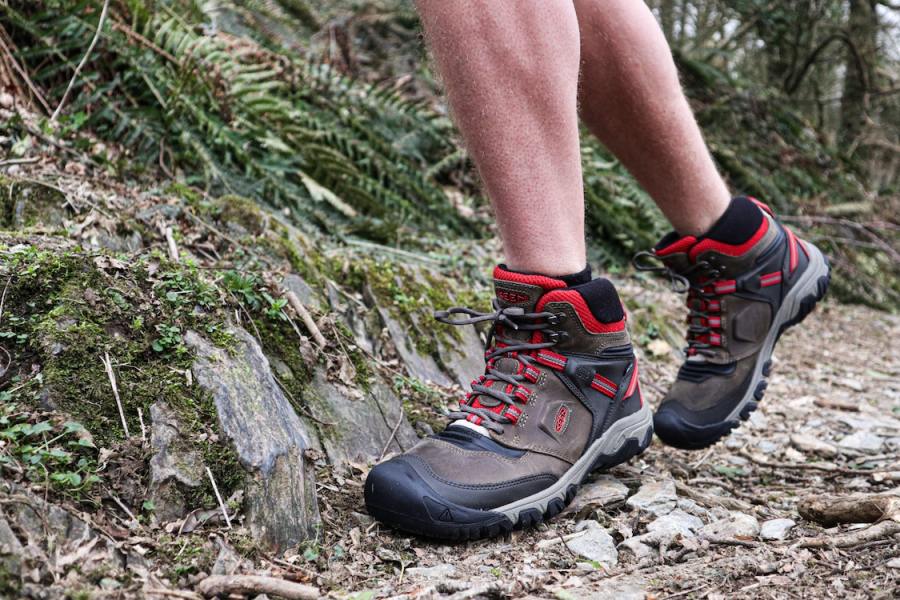
Leather hiking boots or synthetic?
Leather and synthetic hiking boots have their own advantages and disadvantages when compared against each other and it’s difficult to say which type is best as it depends on numerous factors. Here are some of the key differences between leather and synthetic hiking boots:
- Durability: Leather hiking boots are generally more durable than their synthetic counterparts, as leather is a stronger and more resilient material.
- Water Resistance: Leather hiking boots are naturally resistant to moisture, while synthetic boots require additional waterproofing treatments to provide adequate protection against water.
- Breathability: Synthetic hiking boots are generally more breathable than leather boots, as synthetic materials tend to allow air to circulate better than leather.
- Weight: Synthetic boots are generally lighter in weight than leather boots, making them a better choice for hikers who like to feel light-footed on the trail.
- Cost: Leather hiking boots tend to be more expensive than synthetic boots. That’s due to the higher cost of the materials and the additional labor required to construct them.
- Maintenance: Leather needs to be regularly cleaned and conditioned to maintain its durability and water resistance, so it’s fair to say that leather hiking boots require more maintenance.
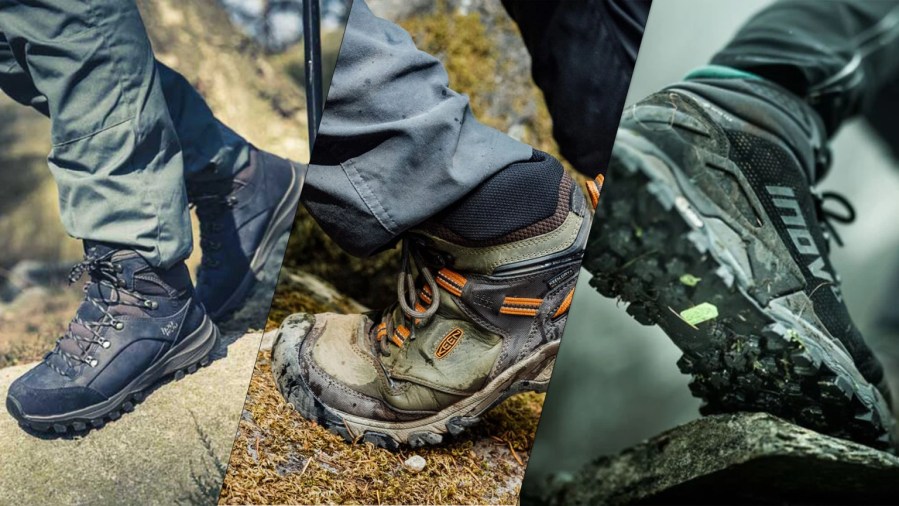
Should hiking boots be waterproof?
Some hikers will favour non-lined walking boots even when hiking in wet conditions. This will generally be if they own quality, leather boots that have minimal seams and that are well maintained with water resistant wax. It’s a traditional approach but one that many will swear by – check out our guide to re-waterproofing hiking boots and shoes for more info on that. Almost all of the options assessed in this round up have waterproof membranes, but you will find in some instances that brands will sell non-lined versions of them too.
Bear in mind, if your boots are a little old and broken, you could consider whether you can fix them up. This guide on how to repair hiking boots should help there.

